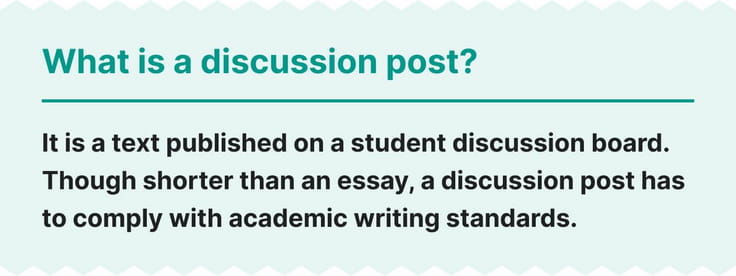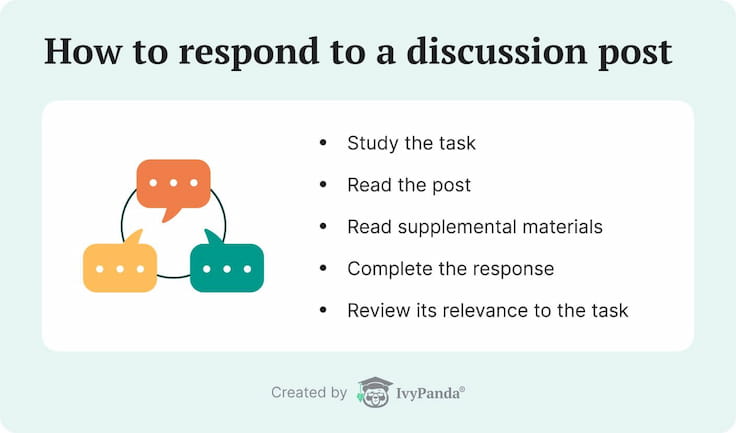
The discussion board response is made by AI. Please use it for reference purposes and inspiration only.
Table of ContentsOur free discussion board response generator is user-friendly and straightforward. Just follow the steps indicated below:
First, choose if you want to generate a discussion board post or a reply to your classmate’s post.
If you want to get a post:
If you want to get a reply:
As you can see, things work pretty simply with our discussion board reply generator. You just need to do a couple of actions, and the tool will prepare a well-organized response in line with your classmate’s discussion board content.
A discussion post is quite a short text published on a student discussion board.

Discussion posts are often used in any learning course because:
Though easier to write than ordinary essays, discussion board posts still have to comply with the standards of coherent and informative academic writing.
A typical discussion post should have a central argument or idea you’re looking at, and it should also offer concrete evidence (sometimes with sources) to substantiate that point.
Now, let’s talk about the generic structure a discussion post should follow.
The rule of thumb is to have 3 main elements in this piece of writing:
How to end a discussion post?
This question often troubles students, as they usually need to formulate a thought-provoking question that would fuel further discussion of their raised topic. It’s not always required, but you can still encapsulate a rhetorical question or suggestion for further discussion in the concluding sentences of your discussion post.
If you’re new to discussion post responses, here are some simple steps to guide you through the process.

Here are the steps necessary to reply to a discussion board post:
| Study the task | It’s impossible to cover a discussion post response well if you have only a vague idea of the discussion instructions. So, read the prompt inside out to understand what exactly is needed from the post authors and those who respond to them. Mind the format and word count instructions. |
|---|---|
| Read the post | Now that you know what’s needed from you on the task, it’s time to study the post carefully. Read the content, underline the action words and main idea, and shape your initial idea of the post. |
| Study the materials | Study all assigned additional readings to capture the topic and broaden your understanding of the subject as you prepare for the response. |
| Write the text | Write a full paragraph of response covering the initial post author’s main idea and supporting evidence. Take care to provide a thoughtful commentary on its relevance, quality of chosen evidential support, and additional questions that arise from your analysis. |
| Review your reply | After you’ve finished writing, return to the prompt and compare the requirements with your response. Ensure all elements comply with the instructions, and you won’t need to rewrite the text. |
Discussion board responses can differ in depth, revealing variations in topic mastery and academic proficiency.
Thus, if you want to impress the professor and create a deeper learning experience for your group, you may apply the following life hacks:
Citing a discussion post in the APA style follows basically the same approach as citing any other digital resource would:
Here is an example of the APA citation’s format:
James, K. (2022, Sep. 12). Re: Ethics of international business [Discussion post.] Walden University Blackboard. https://class.waldenu.edu
In this section, you’ll find a discussion board post example and a reply to it.
Discussion question: What did you learn from the nursing theory course?
I have learned in the course of studies and practice that evidence-based practice formation is a continuous cycle of data collection, critical analysis, and bridging of gaps between theory and practice in the nursing workplace. It takes time and effort, as nurses have to collect large amounts of data on a daily basis and subject them to academic scrutiny for the sake of new knowledge and practice generation. Yet, these efforts always pay off because they link nursing theory and practice and allow nurses to make a difference by delivering tangible, data-backed solutions to existing healthcare problems. These activities inevitably shape continuous healthcare service improvements, resulting in greater patient satisfaction.
I find Janie’s post very insightful and personal; I share many of her reflections on the process of nursing theory studies and months of nursing practice in the workplace setting. Indeed, as Mateo and Foreman (2013) confirmed, evidence-based practice is typically born out of the nurse’s careful and close attention to the details of nursing care they witness and deliver on a daily basis. Once a problem or inefficiency in care delivery is identified, a nurse may work this problem out by researching its fundamental causes and offering theory-backed solutions to improve the situation. This way, no evidence-based practice improvement can emerge in the nursing practice without a continuous cycle of meticulous data collection and assessment, reworking of all relevant theories underlying that issue, and the proposition of workable solutions based on solid clinical evidence. However, I would also note the typical challenges in the nursing practice, such as conceptualizing evidence in EBP and nurturing the critical thinking mindset among nurses that can enable continuous practice improvements.
Updated: Jul 19th, 2024